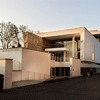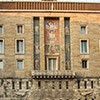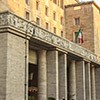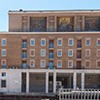
New layout of the Emperor Augustus Square (Piazza Augusto Imperatore) in the middle the Mausoleum of Augustus

Altar of Peace (Ara Pacis) from the time of Mussolini, Vittorio Morpurgo, pic. Wikipedia

Museo dell'Ara Pacis, Richard Meier Pavilion, 2006

South frontage of the square (Piazza Augusto Imperatore)

South frontage of the square (Piazza Augusto Imperatore)

Piazza Augusto Imperatore - the southern frontage of the square, mosaics by Ferruccio Ferrazzi - The legend of the rise of Rome

Piazza Augusto Imperatore - The personification of the Tiber River, Ferruccio Ferrazzi, pic. Wikipedia

Piazza Augusto Imperatore - the southern frontage of the square

Piazza Augusto Imperatore, one of the reliefs decorating the square

Piazza Augusto Imperatore - eastern frontage of the square

Piazza Augusto Imperatore - eastern frontage of the square, main entrance frieze

Piazza Augusto Imperatore - eastern frontage of the square, main entrance frieze, fragment

Piazza Augusto Imperatore - eastern frontage of the square, main entrance frieze

Piazza Augusto Imperatore - arcades in the eastern frontage of the square

Piazza Augusto Imperatore - building of the Pontifical Croatian College of St. Jerome

Piazza Augusto Imperatore, in the distance the Church of San Girolamo dei Croati

Piazza Augusto Imperatore - frieze on the building of the Pontifical Croatian College of St. Jerome

The Christianization of the Croats, Jozo Kijaković - Piazza Augusto Imperatore - frieze on the building of the Pontifical Croatian College of St. Jerome

The Mausoleum of Emperor Augustus, the inner cylinder of the building - the central part of Emperor Augustus Square (Piazza Augusto Imperatore)

Mausoleum of Emperor Augustus, remains of the main entrance to the building - Piazza Augusto Imperatore

Mausoleum of Emperor Augustus, the present condition of the interior of the building - Piazza Augusto Imperatore

Mausoleum of Emperor Augustus, interior, restored - Piazza Augusto Imperatore

Emperor Augustus Mausoleum and Emperor Augustus Square in the 1930s

The Mausoleum of Emperor Augustus and the square surrounding it (Piazza Augusto Imperatore) - a new urban concept
The ruler of Fascist Italy, Benito Mussolini looked at himself as the heir of Roman emperors, but only one was his favorite. This was Octavius Augustus, who was remembered in history as an example of an excellent leader who ensured his subjects peace and prosperity. And thus the grand exhibition, planned for 1938 was devoted to this ruler as a commemoration of his birthday. Many guests were invited (including Hitler, who was also a proponent of Octavius), while the opening of a square (a new Roman forum), surrounded by new, monumental buildings served as an added attraction. At the center of this square, the restored after many centuries mausoleum of Octavius Augustus was to be unveiled. In this way, Fascist Rome paid homage to the great emperor, at the same time praising his successor and continuator, which is how the Duce saw himself.
The ruler of Fascist Italy, Benito Mussolini looked at himself as the heir of Roman emperors, but only one was his favorite. This was Octavius Augustus, who was remembered in history as an example of an excellent leader who ensured his subjects peace and prosperity. And thus the grand exhibition, planned for 1938 was devoted to this ruler as a commemoration of his birthday. Many guests were invited (including Hitler, who was also a proponent of Octavius), while the opening of a square (a new Roman forum), surrounded by new, monumental buildings served as an added attraction. At the center of this square, the restored after many centuries mausoleum of Octavius Augustus was to be unveiled. In this way, Fascist Rome paid homage to the great emperor, at the same time praising his successor and continuator, which is how the Duce saw himself.
After a few years of planning in 1934 in front of cameras, Benito Mussolini, struck the first blow with the pickaxe, thus giving the signal to begin the works. One hundred twenty buildings were destroyed, ones that from ancient times tightly surrounded the mausoleum of Augustus, which was protected from the weather conditions by a roof. Underneath was an auditorium that had been functioning since 1907, where numerous concerts took place. A medieval hospital (Ospedale di San Rocco), situated near the Church of San Rocco, also fell victim to the new investment. Another church – the San Girolamo dei Croati, was also stripped of all surrounding buildings. In this way, the medieval tissue, which had existed here – 28 thousand square meters of densely built-up area reaching all the way to the shores of the Tiber – was lost in a matter of months. Fortunately, a decision was not made to tear down the two aforementioned churches which in a significant way disturbed the composition of the newly-erected complex. The principal architect of the whole arrangements was Vittorio Ballio Morpurgo as well as the trusted architect of Mussolini, who supervised all the works in the city – Marcello Piacentini.

It must be added that the Duce had for years attempted to restore the sites of ancient Rome. He ordered (a hurried) restoration of the ancient buildings but also wanted them cleaned of the added elements of later eras, in this way irrecoverably destroying significant parts of the city. The Fascist propaganda even introduced a new term: “Mussolini’s Third Rome” – meaning the Fascist one, created after the time of ancient emperors, and modern popes, in which the Duce played a similar role to those figures – a founder and guardian of the city. In 1936 Italians entered Ethiopia, hoping to create a great imperial power, equal to that of Great Britain or France. In this way, the idea of a great Rome acquired the form of Mussolini's new empire. The buildings situated around the square were to in an outstanding fashion document and praise – let us see how they fulfilled this role.
In the Western part of the newly-created square (via di Ripetta) an ancient foundation of the Roman Senate was placed, commemorating Emperor Octavius Augustus – The Altar of Peace (Ara Pacis). This structure, which had been until then located at the Field of Mars (Campo Marzio) was supplemented and quickly restored, and then enclosed with a glazed building according to the design of Morpurgo. (Let us remind ourselves that to the ire of many Romans in 2006 this was replaced by a modernist complex designed by Richard Meier).

The three remaining wings of the square were occupied by high, travertine-covered buildings erected in the style of Italian Rationalism, meaning to house offices and state halls. Their monumental façades were filled with small windows and made to look the same with high porticos, in order for them to optically create a cohesive whole. The structures were bereft of needless decorations, while those that were present, mostly expressed propaganda content. The task of architecture was not only to fulfill certain functions but also to educate.
And so, the elevation of the enormous building found in the southern part of the square was adorned with mosaics referring to the founding myth of the Eternal City. Their creator, Ferruccio Ferrazzi, presented his own interpretation of the legend which of course could not do without the She-Wolf, the twins (Romulus and Remus), held by a giant personification of the Tiber, as well as ancient deities. The following could be seen: on the left: Juturna (the goddess of fountains, springs, and wells), Diana with a dog (the goddess of the hunt), Vesta (the goddess of the hearth and home), and on the right – Ceres with ears of grain (the goddess of agriculture), Vulcan (the god of fire and the forge), and Saturn (the god of agriculture and wealth). The giant, chiseled in stone, Latin inscription placed below between to winged geniuses holding the ancient Roman symbol of power in their hands – fasces (also an attribute of the Italian Fascists), still today informs us that this long-forgotten site, which is filled with the spirit of Emperor Augustus, along with the separated until that time parts of the Altar of Peace, were brought out of obscurity by Mussolini, tearing down old buildings, to make room for magnificent streets and buildings in order to ensure Romans with the appropriate homes. At the end, there was information that the building was created in 1940 – in the 18th year of the Fascist revolution. In this way, we found out not only about the praiseworthy saving of relics from the past, but also about Duce’s caring about the fate of the inhabitants of Rome, who had lived here until now, and displaced (often against their will) found new homes in neighborhoods situated on the outskirts of the city, the so-called borgate. The elevations are competed by a fountain mounted into the wall, with a simple form. In recent times the building was purchased by Bulgari, while in 2022 an exclusive hotel is scheduled to be opened.

In the eastern frontage, we will see two parts flanking a central façade equipped with an enormous niche with a portico supported on massive pillars. The principal decoration of this imposing building is a frieze in the architrave. Its most important element is an inscription chiseled in stone informing us that "the Italian nation, is an immortal nation, which always finds Spring for its passions, hopes, and its greatness”. The further part of the architrave is adorned with figures: a worker with a pickaxe and a spade, farmers, breeders, personifications of the arts (architecture), women with children – meaning all those who were meant to notice and appreciate the efforts of the Mussolini regime. Moving on, we come across an impressive apse of the Church of San Carlo al Corso and the figures of SS. Charles and Ambrose flanking it.
In the northern frontage of the square, there is a building of the Pontifical Croatian College of St. Jerome destined to educate the clergy from the southern Slavdom, belonging to the Church of San Girolamo dei Croati found next door. It was erected on the site of destroyed church buildings. The middle part of the building towers over the two side wings, while at its base there are mosaics – the works of Jozo Kijaković referring to the Christianization of the Croats (The Baptism of the Croats and the Coronation of the Croatian King Demetrius Zvonimir in 1076).
The buildings surrounding the square were finished in 1941, but the square itself was not completed until 1952. The mausoleum’s restoration was never successfully concluded, as the challenge proved too great even in the times of Mussolini. The remains uncovered during archeological works were disappointing – they could not be used to create a sufficiently imposing monument. The mausoleum also seemed too smallish even inconspicuous. The only thing left from the original building was the cylinder of the wall, which nobody knew what to do with. It was planned to adorn it with an enormous statue of the emperor with eternally burning torches and a group of statues guarding it, but ultimately it was decided to use this site for manifestations and ceremonies. And here is where the short life of the mausoleum (and what was left of it) ended. For nearly one hundred years it stood abandoned and forgotten, awaiting a second chance at life.
The opening of the square to the public along with its modernization is planned for 2022. Let us hope that thanks to this undertaking, the square will become not only a souvenir of Fascist ambitions but also a place that is friendly for Romans, while the mausoleum itself will finally, successfully be brought back to life.



























































